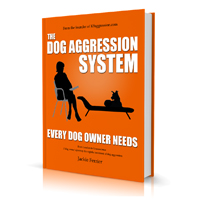Your cart is currently empty!
Clicker training: an introduction
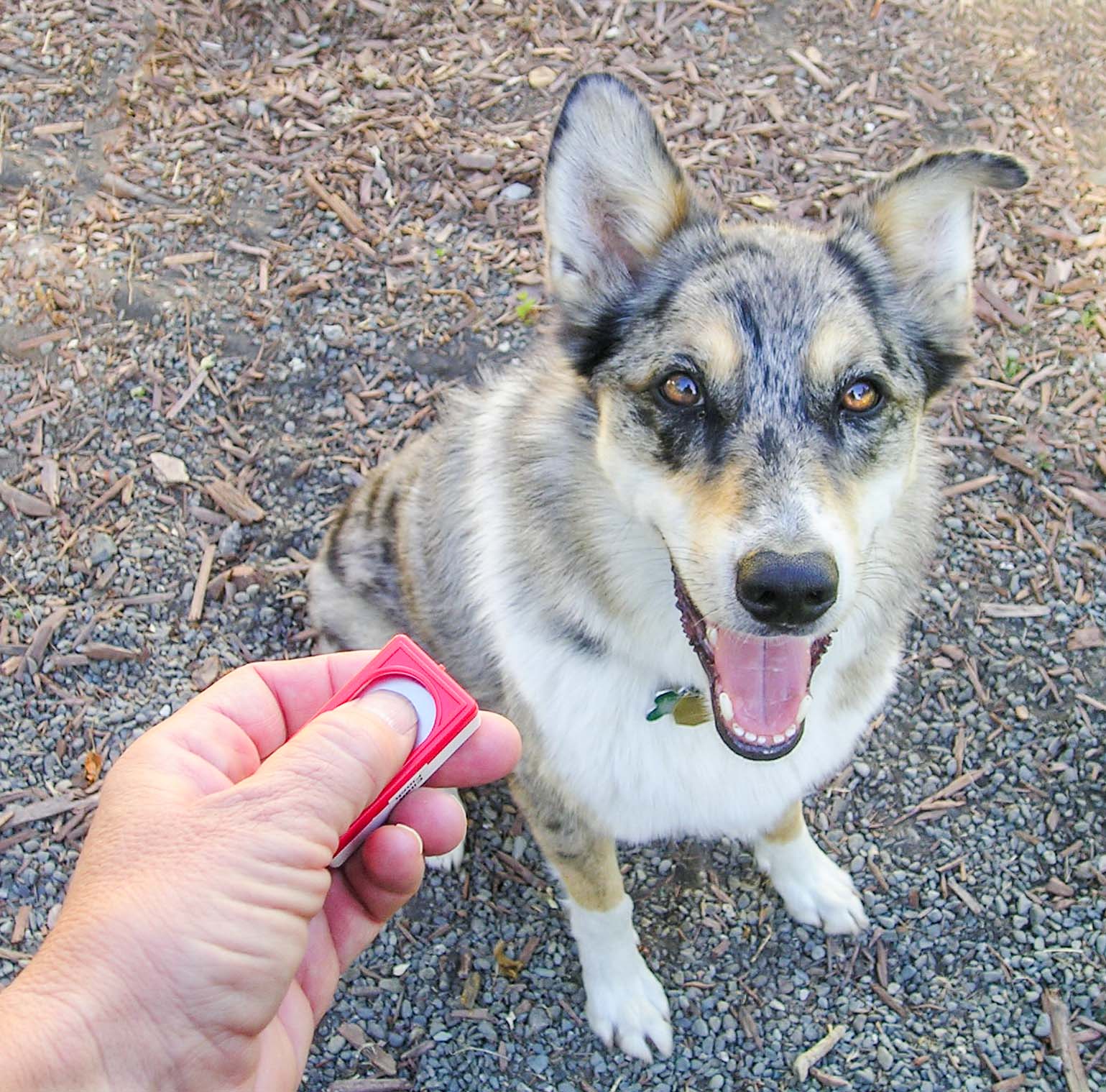
Clicker training can be a highly effective approach for many animals (dogs, chickens, horses, dolphins, etc.), but is especially useful for aggressive dogs. It is an extension of training many people instinctively already do: when the dog behaves in a way we find desirable, we give them a reward.
In this case, the clicker let’s the dog know the exact moment they were doing something right. This allow you to more precisely communicate what behaviours you would like the dog to repeat. This reduces the time it takes for a dog to learn something new. It also allows you to break down more complex behaviors into smaller more management steps. It also increases the bond you have with your dog which can be be helpful in encouraging them to do or not do what you want.
On this page:
- How does clicker training work?
- Why dogs are motivated to learn with clicker training
- Why using clicker training is good for aggressive or reactive dogs
- Using luring with clicker training
- Teaching the dog how to respond to a cue or command
- Why we use food and whether we can use other rewards instead
- Whether or not we always have to use the clicker or have it with us
- Where to buy clickers
- Seeing clicker training in action
- Troubleshooting
- Other resources
How does clicker training work?
Clicker training when done right is more than a reward system. It acts as a communication system where your dog is an active and willing participant. Clicker training takes advantage of your dog’s innate ability to:
- Recognize patterns (Hey, my owner clicks every time I turn my head in that direction, let me try that again) and
- Experimentation (hey, my owner stopped clicking and rewarding me for turning my head, what if I turn my whole body?).
This allows us to “shape” our dog’s behavior giving us the ability to even create complex behavior sequences if we desire. It’s very different approach that trying to get our dogs to do something and then rewarding because it relies on your dog initiating behaviours first without out trying to lure them or push them into something.
There is essentially four initial stages to clicker training. Creating associations between food and clicker and then clicker and behavior, encouraging experimentation in order to shape the behavior, and finally linking the command word to the learned behavior. If you incorporate this into your regular training, you probably only need to make the link between the clicker only once. But even if your dog forgets because you haven’t done it awhile, it’s easy to create the association again
Part 1 – Creating the association between clicker and food
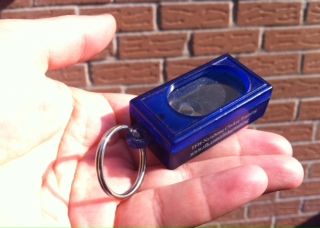
A clicker, or any marker is meaningless to a dog when they first hear it. So we set up a situation that allows them to predict the arrival of a food treat after the click.
- Click the clicker at a distance where the sound won’t startle tour dog like in another room or muffle it so they get used to it and it’s not associated with anything unpleasant.
- Click and give your dog a treat. Repeat. Your dog doesn’t need to do anything at this point. repeat several times (some suggest by ten repetitions, they will get it, but all dogs are different). Work in an area with little distraction.
- Be sure to vary the time between each clicks/treat pair. Once you see your dog’s ears perk up and they look as if they expect a treat at the sound, you are probably are ready to go the next step. If not, repeat until they do.
• TIP: Don’t use the clicker for anything else other than clicking it and following that up with food. Children will have a hard time with this. let them click it out of the presence of your dog.
Part 2 – Creating the association between behavior and clicker
- This time click every time he or she turns their head to the left even if it’s only a little. You will have to watch them carefully to catch it each time. At some point your dog will recognize there is a pattern and start to deliberately turn his or her head left as long as you continue to click and reward for it.
- Repeat until your dog is deliberately doing it and the behavior is reliable and consistent.
TIP: Practice your timing on a person so you avoid confusing your dog with bad timing.
What’s the point of getting my dog to turn their head?
You don’t have to train your dog to look in a direction. However it’s simple and gets your dog to focus on making the connection between what he or she is doing and the click. Some people teach clicker training by getting the dog to touch their hand or to look at you. However, these methods can potentially get the dog to believe is something you’re doing (looking at them, reaching your hand out, etc.).
After the first few times of successful training different things your dog will learn very quickly to pay attention to what he was doing at the time he heard it.
TIP: It helps to hide the clicker behind your back so they associate the sound – and not your hand movement with the treat. Click with one hand and give treats with the other. Have a few in your hand so you don’t delay in giving the treat.
Putting it into human terms: At the exact moment that someone you do something right, your coach says something like, “That’s it!”
It’s like playing the game of Hot and Cold, where the word “warm” tells you something you did is right, even if it only means you are close.
We would call the “That’s it” or “warm” in the Hot and Cold game a marker. It marks or points out and isolates the moment that we were doing something correctly. The click sound is a marker pointing out the exact moment the dog has done something right that will earn them a treat. Training different things behavior eventually teaches them to pay attention to their own behavior.
Part 3 – Shaping
Think of behaviour as being a ball of clay that you are shaping into a desired form. Each press into the clay gets it closer and closer to the end result. Or in the game of Hot and cold, every time you say “warm” the person gets closer and closer to the goal. That’s how shaping works. The final behavior is made up of small pieces. Sitting, for example could be broken down into:
- The dog first makes the decision to sit and start to bend their legs.
- The dog’s bottom touches the ground.
- Staying for a moment.
- Staying for increasingly longer periods of time.
How do move the dog from one step to the next?
This relies on withholding the treat until your dog does something a little bit different.
When you first start this you have to understand that your dog is not only learning a new skill, but they are also learning the system of how the training works, so be patient and expect it will take some time and they’ll tire more quickly than you are used to.
Once they understands the system, they will learn things much faster because he’ll know to look for patterns, and experiment when they don’t get the click.
Let’s give an example of teaching your dog to go to his or her mat. You might start by clicking every time your dog looks at their mat.
- Make sure your dog is reliably and consistently doing the first behavior. In this case we are going to watch for the dog touching his mat, or looking at it and click that action. We’ll repeat this until your dog starts to understand that there is a pattern associated with the click and what he is doing. We’ll have the mat quite close to us. We will also have plenty of time and be patient.
- Once the dog is consistently performing the action for the treat (you’ll know, he’ll be doing it on purpose) don’t click until they do something different (as long as it is not undesirable behavior like barking). Quite often they will first start with making their behavior more obvious because you must have obviously been blind to what they were doing! Maybe they really turn their head more obviously or they put a second paw on the mat, so you click that for a while a long as they are doing those new actions consistently.
- Next time only click when they have done something to progress to the eventual goal of sitting or lying down on the mat and continue on with these baby steps until they are doing it.
- Once they are touching the mat reliably, be sure to move them just off the mat by delivering the treat off the mat, so they learn that only be going to the mat with they get the click.
- If he or she doesn’t do anything or doesn’t get it or appears to give up, just wait it out. Sometimes they need a break, sometimes they need to figure it out in their heads, sometimes they test you. If it still doesn’t work, go back to the previous step and break the behavior down into smaller pieces and click for more subtle differences.
- If they get their behaviour much closer to what you are looking for you can give them a jackpot (extra food).
It may be a little frustrating to your dog at first that you have stopped clicking but it will usually motivate them to try something else.
• TIP: If it’s your first clicking experiment you might want to click for anything different that is not undesirable. This way the dog understand he is being rewarded for doing something different. Dogs that have done this a few times learn to try new things and this turns training into a fun game.
Your job is to get your timing right. Its their job to guess what it was so they can make it happen again. Don’t work too long!
Once your dog “gets it” and is performing the action consistently, we raise the bar and expect something slightly better or slightly different.
This is the essence behind shaping which allows us to train a dog to do some fairly complex things.
Part 4 – Teaching what the command/cue word means
Other kinds of training often starts with the command and then physically manipulate or lure your dog into what you want, then reward.
With clicker training the command or cue word comes last. The goal is to have your dog use the word to predict the behavior/reward sequence will start.
- Once your dog is reliably doing whatever it is you want to train, you say the word just before the he or she is about to perform. Initally the probably won’t pay much attention to the word but repeat this several times.
- Stop saying the word and stop clicking when they perform the behavior sequence.
- Say the word and click/reward a few times.
- Then don’t say the word and don’t click and reward. Alternate between the two so they learn that it is only when you say the word first do they get the treat
• TIP: Again, this takes the longs to learn when they are just learning the system. There is a lot to focus on for your dog, he or she is probably going to get confused and mentally tired. Be patient.. It’s worth it.
Why clicker training is so effective
There are many methods of dog training, but clicker training is one of the more versatile and effective methods when we get our timing right. Dogs can be taught to huge variety of things by chaining behavior sequences together
Clicker training activates more than one motivation to learn
How do we feel when we get that kind of feedback? We usually feel good. We usually feel good for one or two reasons.
- We feel good for getting a reward
- We feel good from the satisfaction of having mastered something
Studies have shown that we are more motivated because of intrinsic motivation than we are extrinsic motivations. In fact, external rewards and punishments can reduce our internal motivations.
When dogs start this kind of training, they can get frustrated especially if they have never had to problem solve in a context like this before. But once dogs understand the game, suddenly something shifts. You will see a focus and engagement from many dogs that goes beyond what they used to do working for a treat. So what is happening? We can only assume that the dog is finding a new satisfaction in figuring out the problem.
Problem Solving Is Satisfying
Solving a problem either brings satisfaction or relief. The biggest challenges for wild animals to solve is how to find and catch food. Hunters are required to attention to the habits and behavior of their prey and figure out how to catch them whether by thinking about it or trial and error. When they succeed, they are rewarded and are motivated to remember how they did it.
Contrast this with most domestic dogs who are powerless to determine their next meal and often do nothing for it to be placed on the floor.
Psychological reactance is a term that applied to humans. It is basically the resistance we experience in response to offers, rules or regulations that threaten or eliminate our behavioral freedoms. In other words: we don’t like being told what to do and will resist doing it just because someone else is making us.
The Illusion Of Control Reduces Stress
Click training provides the illusion of control for dogs. This is likely far more important than most people account for. So-called dominance theories would have us believing that humans should be in control of dogs at all times, and dogs should know this. Experiments have shown that even the illusion of control significantly improves performance. (1)
We don’t know if it applies to other species. However the theory behind psychological reactance is that it is motivated by the need for self-determination in how we will affect our environment.(2) Given this viewpoint it makes sense that dogs also do not want their freedom threatened. Click training gives them this freedom.
Intrinsic Motivated Learning Lasts Longer
Extrinsic motivation is the result of being motivated by an external factor whether that is a reward or punishment. When we are motivated by our own personal motivations, the learning lasts longer. The desire to master a skill is intrinsic. The satisfaction gained from solving a problem that motivates us to try again is also intrinsic.
Clicker Training Reduces Confusion
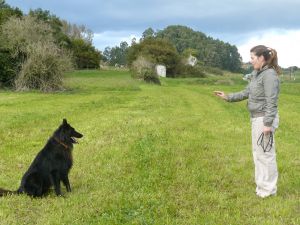
The difference between teaching people and teaching dogs, is of course, language. We can specifically tell people what we want. Dogs have to guess by observation, and trial and error.
For example, if the dog sits, is the dog getting a treat because we walked into the kitchen? Or because he looked at you? Or maybe because he was confused and didn’t know what to do so he sat? Maybe it was because he turned his head just before you gave him the treat. What is the dog paying attention to when you push on his or her hips to sit. The sitting or the interaction?
A clicker is a hugely effective tool to bridge this gap.
Dogs don’t have the opportunity to ask us what we mean, or what were they doing right, but the clicker can tell them. As soon as the clicker sound is heard, the dog pays attention to whatever was happening at the time so that he or she can try to repeat it.
It is this specific function that is the communication, and it is this clear communication that provides the benefit in training. It means that you will have to develop good timing with the clicker. The video below has some good suggestions on how to get better with timing.
Why Clicker Training Can Be Helpful For An Aggressive Dog
Clicker training can be beneficial to an aggressive dog because:
- Clicker training can be used in Behaviour Modification such as teaching a dog to relax which may otherwise be very difficultMany aggressive dogs are anxious. Clicker training provides added communication.
- Clicker training avoids having to get forceful or physical with your dog thus avoiding conflicts.
- Clicker training promotes self-awareness in the dog.
- Clicker training is enjoyable for dogs keeping their attitude positive.
- Control reduces stress. Clicker training provides an acceptable amount of control without undermining the handler.
- Clicker training can be fun encouraging you to work more frequently with your dog.
- Clicker training delivers breaks training down into many small goals which leads to many more moments of success which is motivating for the handler
- Clicker training can be used to teach all kinds of different behaviours such as paying attention to you on cue, touching your hand, moving to an area when asked and so on, giving you many options to manage aggression more effectively and safely.
- Clicker training works on prediction. Predicting outcomes keeps your dog’s mind active and working. This not only makes life more satisfying for dogs but it also helps them maintain their cognitive skills as they age
Using luring with clicker training
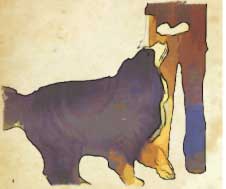
Luring is not clicker training but it is a technique that can be used to encourage a dog to do something and the clicker can let the dog know to repeat the action. It involves using a treat to get an action out of a dog.
For example, if we want to lure a dog into sitting we might show the dog the treat in our hand and move it slowly from in front of his face to over the top of head. At a certain point, the dog’s head can’t go any further back to keep his or eye on it, unless they sit. Bingo! Then we click and reward.
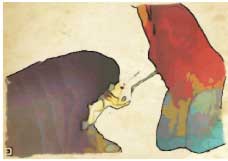
Another example of luring can be used to teach the dog to lie down.
One the dog is sitting, take a treat and bring it to the dog’s nose (don’t let them eat it). Then slowly lower it to the ground so the dog follows it with their nose. Once your hand is on the ground slowly move it away from him causing them to stretch to get it. This often results in the dog lying down.
We repeat this a few times, until the dog starts to predict what is happening. At that point you only use your hand with no treat (this is called fading out the lure). Then you make the gesture less obvious. Soon the dog is sitting without it and you’re clicking and rewarding them.
Talented trainers know all sorts of ways to use luring to their advantage. The challenge is in actually “fading out” the lure. This is the process of making the luring motions less and less obvious otherwise they will only do it when you have food in your hand or you make the motion. Fortunately dogs are pretty smart at predicting and require less and less movement from you.
Some trainers avoid luring as it involves manipulation, and changes the dog’s awareness and volunteering activity.
Frequently asked questions about clicker training
Why do we use a clicker instead of our voice?
We use a clicker because the sound is distinct, unique and consistent. Most trainers find that the sound helps the dog focus better. Once the dog has actually learned the behavior many trainers stop using the clicker and use their voice instead. This is a good idea as we always have our voice with us. However the dog has to work harder at discriminating between the marker word you use and other words you use. This means that the dog’s brain is more occupied with that instead of learning. You dog has also learned to tune out your voice when what you say is not relevant to him or her the way we tune out a conversation that doesn’t involve us or get used to the sound of a clock ticking or traffic. The clicker on the other hand is only ever used for training and always means a reward will follow.
Anything could be used as a marker as long as we pair it with reward. Anything could be used for a reward as long as we are motivated enough to attain it. You could use a light flash as a marker with deaf dogs, trainers used whistles for training marine animals.
Why do we reward with food?
Why do we use food as rewards? Because dogs find food highly rewarding. Food can be delivered quickly. Food can be consumed quickly. This allows you to work quickly and maintain your dog’s focus. Some dogs find play more rewarding than food (thinking of some collies) and this may be an alternative. However play cannot be delivered/consumed quickly and it can be distracting. It can also be frustrating for some dogs to end the play which undermines your efforts.
Can dogs be rewarded with praise?
Praise is not as an effective reward as people would like to think. The idea that dogs should work for praise or be motivated enough by praise to be paying rapt attention to us is asking a lot. We enjoy praise. But we wouldn’t exactly trade in our pay check for it, would we?
Can we phase out the treats and just use the clicker?
The clicker is a predictor for a reward, not the reward itself. In time if you stop using food, the clicker will lose it’s effectiveness. You can however phase out the clicker once your dog is consistently performing the behavior is a variety of different situations and contexts.
Do we always have to use the clicker?
Generally clicker is an excellent tool for teaching new behaviours. There is something about the distinct sound of it that helps them focus. But once the dog has learned the behavior, you only need to use treats or other rewards such as play to reinforce the behavior. Once the behavior is well established, you can use treats for it intermittently. Behaviours like sitting can be reinforced by allowing them access to things they want such as a toy, their dinner or going outside, for example.
Where to buy clickers?
You can buy clickers just about in any pet store. They are not expensive. They can come with wrist bands or bands for your finger which saves you dropping them. Some even have a quieter click sound to be sued with noise sensitive or easily startled dogs such as the i-Click clicker(although you can modify a regular clicker easily enough). But if you are having troubles finding them, Amazon also carries clickers.
Here is a short video “Dog Training : How to Use a Clicker to Train a Dog for Specific Behaviors”
See clicker training in action
“Dog Training : How to Use a Clicker to Train a Dog for Specific Behaviors“
Troubleshooting
Sometimes your dog doesn’t respond the way you want. Here are some possible solutions.
- Teaching your dog creativity can be helpful for dogs that have been taught with force-based or punishment based methods. These dogs sometimes refuse to do anything in case of getting “in trouble”. This game helps them over come this. Check out the article on teaching your dog creativity and the video demonstrating a dog playing it. It has sub-titles telling you what the behaviour the dog is doing that they are being clicker for so it is quite useful.
- Your timing might be off. Practice on a human! Practice clicking a bouncing ball the moment it hits the floor.
- Your dog might have learned the behaviour in a particular location or context and doesn’t understand yet how to do it in a new location/context. Dogs discriminate more than we do. Simply repeat the training in different situations and eventually your dog will understand it applies to all situations.
- Your dog might be mentally tired. This kind of training demands a lot from your dog cognitively. Take a break.
- You might not be waiting long enough for your dog to figure out what to do.
- You might be asking for too much and your dog doesn’t know what you want. Break the behavior down into smaller steps.
- You might not be rewarding often enough and your dog is losing interest. Your treats are not motivating enough.
- You might be using a “no reward marker”. This means you are letting the dog know when he’s getting it wrong. Unfortunately although it seems logical to communicate this to reduce the amount of times your dog repeats something you are not looking for, it interferes with their motivation to keep trying.
- Your treats are not motivating enough. Try a higher value treat
- Your treats might be so good they’re distracting
- Your dog is deaf or hard of hearing. Try a light or a touch for a marker
- Your dog startled at the clicker and now hates it. use a different sound or a quieter clicker
- You may have used the clicker after the reward. Practice on your own.
- You may have used the clicker as a form of trying to get your dog’s attention. Use food instead as a way to get your dog’s attention and start from the beginning.
- Too many distractions. When teaching something new, make it as easy as possible for them to learn by removing distractions. As they learn you can introduce a mild distraction and as they succeed you can increase the distraction level.
Other Clicker Training Resources
If you are just starting out, you will be interested in this article Fifteen Tips for Getting Started with the Clicker.
If you are a beginner and want more of a how-to book, you may want to check out this book out on Amazon as it is geared towards new learners and includes pictures. Always helpful! Clicking With Your Dog: Step-By-Step in Pictures (Karen Pryor Clicker Books) by Peggy Tillman
References
(1) Perlmuter LC., Monty RA.,The Importance of Perceived Control: Fact or Fantasy? Experiments with both humans and animals indicate that the mere illusion of control significantly improves performance in a variety of situations, American Scientist Vol. 65, No. 6 (November-December 1977), pp. 759-76
(2) Dillard JP., Pfau M.,The Persuasion Handbook: Developments in Theory and Practice, SAGE 2002
Image credit: By Elf at the English-language Wikipedia, CC BY-SA 3.0, https://commons.wikimedia.org/w/index.php?curid=15582233
ADVERTISEMENT
The Dog Aggression System Every Dog Owner Needs E-book
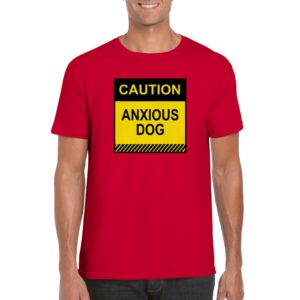
Anxious Dog Shirts only available in our shop
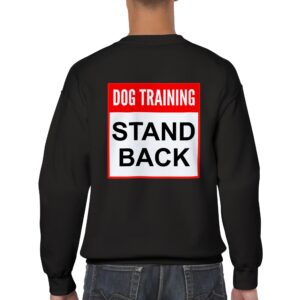
Keep people away with our Stand back shirts
ADVERTISEMENT
ADVERTISEMENT
Tags:

